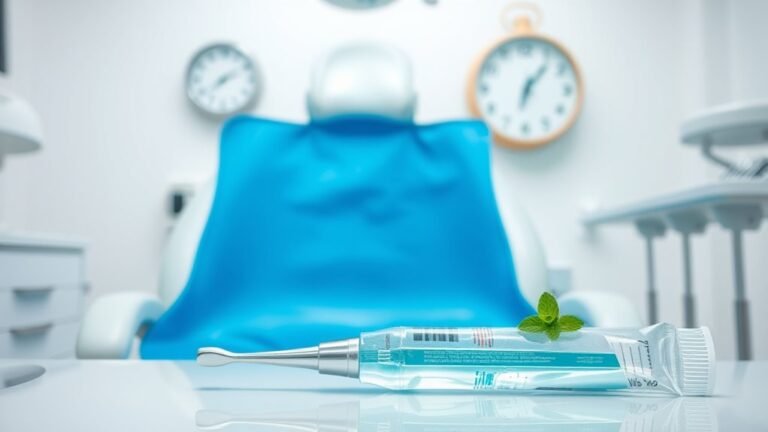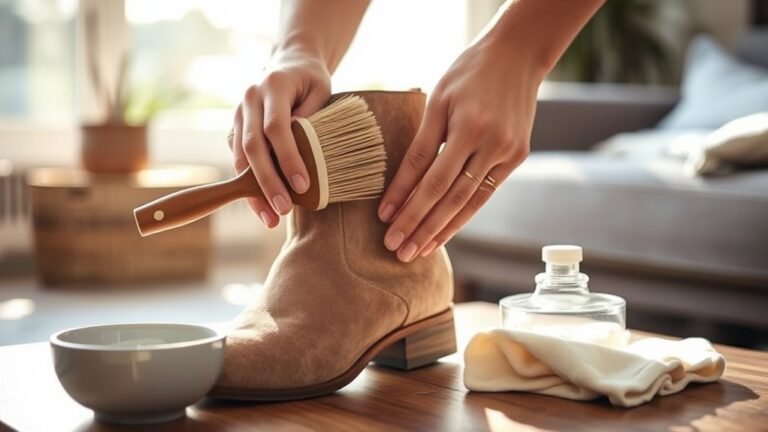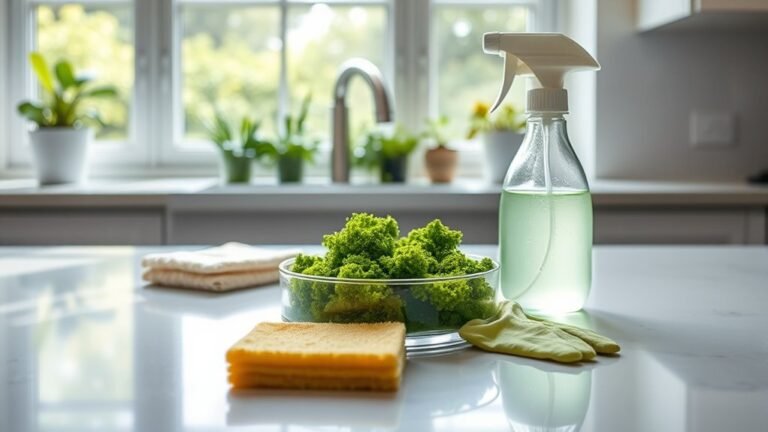DIY Cleaner for Toys
You can easily make a safe, eco-friendly DIY cleaner for your child’s toys using simple ingredients like white vinegar, water, and a bit of gentle castile soap. Adding natural essential oils like tea tree or lavender boosts cleaning and leaves a fresh scent. This homemade solution avoids harsh chemicals, protects your little one, and helps reduce waste. Plus, it’s cost-effective and customizable. Keep your toys germ-free and safe—more tips on making and using these cleaners come next.
Benefits of Using a DIY Toy Cleaner
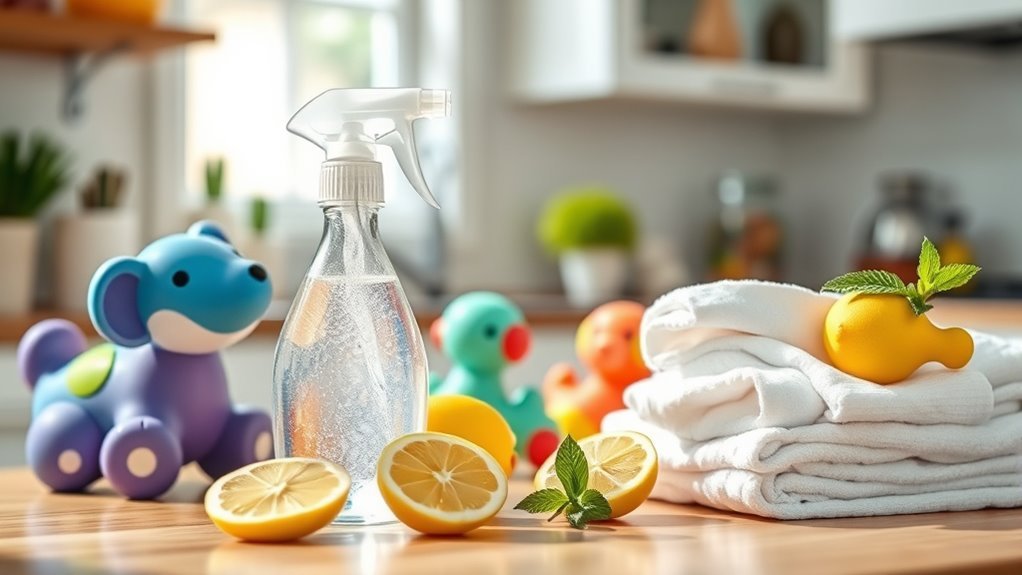
While commercial cleaners can be effective, making your own DIY toy cleaner lets you control the ingredients, ensuring they’re safe for your child. When you choose DIY, you gain eco friendly benefits by avoiding harsh chemicals that can harm the environment. You’re also free from the packaging waste that often comes with store-bought products. Beyond that, DIY solutions are incredibly cost effective; you can use simple, affordable household items instead of expensive specialty cleaners. This freedom allows you to tailor your cleaner to your needs, mixing just what you require without overbuying. Plus, knowing exactly what’s in your cleaner provides peace of mind, especially when it comes to your child’s health and safety. Embracing DIY means you’re choosing freedom, savings, and environmental responsibility all at once.
Essential Ingredients for Homemade Toy Cleaners
You’ll want to choose safe cleaning ingredients that won’t harm your child or their toys. Natural antibacterial options like vinegar or tea tree oil can help keep germs at bay without harsh chemicals. Plus, using non-toxic preservatives guarantees your cleaner stays effective and safe for repeated use.
Safe Cleaning Ingredients
Because toys come into constant contact with little hands and mouths, choosing safe cleaning ingredients is essential for homemade toy cleaners. You want to avoid harsh chemicals and instead opt for eco friendly options that protect both your child and the environment. Simple ingredients like distilled water, white vinegar, and gentle castile soap create a safe base. Adding a few drops of essential oils, such as lavender or tea tree, not only introduces a pleasant scent but also offers natural cleansing properties. These oils are powerful yet safe when used properly, giving you peace of mind. By selecting these safe, natural ingredients, you maintain freedom from toxins while keeping toys clean and fresh—perfect for your little one’s health and your eco-conscious lifestyle.
Natural Antibacterial Options
Choosing safe cleaning ingredients is just the start when making your own toy cleaner. To truly protect your little ones, you want effective natural antibacterial options. Homemade disinfectants using essential oils like tea tree, lavender, or eucalyptus not only kill germs but also leave a fresh scent. These oils have natural antimicrobial properties, making them powerful yet gentle alternatives to harsh chemicals. You can easily add a few drops to a water and vinegar solution for a quick, safe spray. This way, you control exactly what touches your child’s toys, giving you freedom from commercial cleaners loaded with unknown additives. Embracing these natural options means you’re crafting a cleaner that’s both effective and mindful of health, perfect for keeping toys safe and sanitized every day.
Non-Toxic Preservatives
While natural ingredients are great for cleaning, adding non-toxic preservatives is essential to keep your homemade toy cleaner safe and effective over time. Without them, your mixture can spoil quickly, leading to wasted effort and potential mold growth. To maintain freshness and safety, consider these natural preservatives and organic options:
- Grapefruit seed extract – a powerful antimicrobial agent.
- Vitamin E oil – extends shelf life and nourishes surfaces.
- Rosemary extract – offers antioxidant properties.
- Alcohol (like vodka) – acts as a natural disinfectant and preservative.
How to Make a Safe and Effective Toy Cleaning Solution
You’ll want to choose gentle ingredients that won’t harm your child or their toys. Mixing them correctly is key to making a solution that cleans well without leaving residue. Let’s go over the best steps and tips to use your homemade cleaner safely and effectively.
Ingredients for Safe Cleaning
Because toys come into close contact with children, it’s important to use ingredients that are both safe and effective for cleaning. When choosing your DIY cleaner, focus on safe cleaning and eco friendly solutions that won’t harm little ones or the planet. Here are four essential ingredients to examine:
- White vinegar – a natural disinfectant that’s gentle and effective.
- Baking soda – excellent for removing odors and grime without harsh chemicals.
- Liquid castile soap – an eco friendly, plant-based cleaner that’s safe for all surfaces.
- Essential oils (like lavender or tea tree) – add a fresh scent and natural antibacterial properties.
Mixing Instructions and Tips
Although mixing your own toy cleaner might seem tricky at first, it’s actually quite simple once you have the right ingredients and measurements. Start by following precise mixing ratios—typically, a cup of water to a tablespoon of gentle soap or vinegar works well. Avoid over-concentrating, as that can harm delicate toys. Use a spray bottle for easy application, shaking gently to combine before each use. When mixing, always add liquids to water, not the other way around, to keep the solution stable. As for cleaning techniques, apply the solution lightly and use a soft cloth or brush to gently remove dirt without damaging surfaces. This approach lets you maintain freedom from harsh chemicals while ensuring toys stay clean and safe for play.
Best Practices for Use
Once you’ve mixed your cleaning solution correctly, knowing how to use it safely will keep both you and the toys protected. Your cleaning frequency should depend on how often toys are used and their toy material. Here’s how to maximize safety and effectiveness:
- Test the solution on a small, hidden area to verify it won’t damage the toy material.
- Use a soft cloth or sponge to gently clean, avoiding harsh scrubbing that could wear down surfaces.
- Rinse toys thoroughly with water after cleaning to remove any residue, especially for porous materials.
- Let toys air dry completely before use or storage to prevent mold and bacteria growth.
Cleaning Plastic Toys With DIY Solutions
When you want to keep plastic toys clean without harsh chemicals, DIY solutions offer a safe and effective alternative. You can whip up simple, eco friendly options using ingredients like white vinegar, baking soda, and mild dish soap. These natural cleaners respect toy safety by avoiding toxins that might harm kids or degrade plastics. Just mix a solution of equal parts water and vinegar, add a bit of soap, and gently scrub toys with a soft cloth or brush. Rinse thoroughly and air dry. This approach not only protects your little ones but also reduces your environmental impact. By choosing DIY, you’re embracing freedom from commercial chemicals and taking control over what touches your child’s toys—making cleaning both safe and satisfying.
Best Practices for Sanitizing Stuffed Animals

Since stuffed animals can harbor dust, dirt, and germs, sanitizing them regularly is key to keeping your child’s favorite companions safe and clean. Prioritizing stuffed animal hygiene means setting a proper cleaning frequency based on use and exposure. Here’s how to do it right:
- Check the care label to choose the safest washing method.
- Spot-clean minor stains with a mild DIY cleaner to avoid overwashing.
- For deep cleaning, use a gentle cycle with cold water and air dry completely.
- Frequently inspect for damage to prevent dirt buildup inside.
Tips for Maintaining Toy Cleanliness Regularly
Keeping stuffed animals clean is just one part of ensuring your child’s toys stay safe and hygienic. To maintain cleanliness regularly, try implementing a toy rotation system. By limiting the number of toys accessible at once, you reduce the chances of dirt buildup and make cleaning easier. Plus, rotating toys keeps playtime fresh and exciting. Always supervise your child during play to prevent toys from being used in unsanitary ways or taken outdoors where they can pick up more germs. Encourage handwashing before and after play sessions to cut down on bacteria transfer. Consistent spot-cleaning with your DIY cleaner also helps maintain hygiene without overwhelming you with constant deep cleaning. These simple habits keep toys safe, clean, and ready for fun while giving you freedom from hassle.
Natural Alternatives to Commercial Toy Cleaners
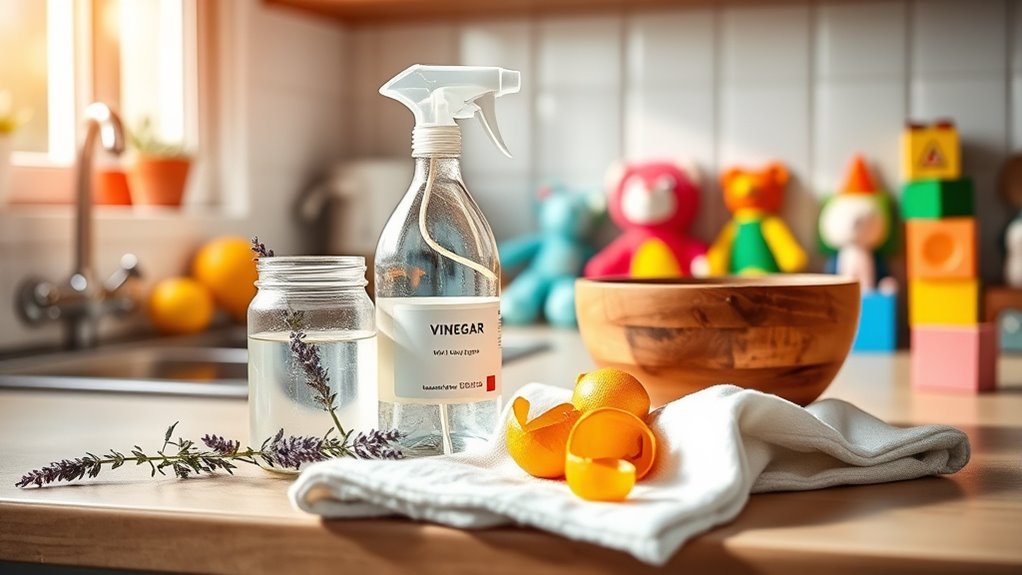
Although commercial toy cleaners are convenient, you might prefer natural alternatives that are safer for your child and the environment. Choosing eco friendly options gives you control over what touches your child’s toys and supports a healthier planet. Plus, these cost effective solutions often use ingredients you already have at home. Here are four natural alternatives to try:
Natural toy cleaners offer safer, eco friendly, and budget conscious ways to keep your child’s toys clean.
- White vinegar diluted with water – disinfects without harsh chemicals.
- Baking soda paste – great for scrubbing stubborn stains.
- Mild dish soap mixed with warm water – cleans gently and effectively.
- Lemon juice – naturally antibacterial and leaves a fresh scent.
Precautions When Using Homemade Cleaners on Toys
When you’re making your own toy cleaner, it’s important to take certain precautions to guarantee the solution is safe for your child and the toys themselves. Start with ingredient awareness—know exactly what goes into your mixture and avoid anything potentially harmful like harsh chemicals or allergens. Next, always perform sensitivity testing by applying a small amount of the cleaner on a hidden part of the toy. This will help you spot any adverse reactions like discoloration or material damage before a full clean. Also, consider your child’s sensitivities; natural doesn’t always mean safe for everyone. By staying mindful and testing carefully, you can confidently create a cleaner that respects both your child’s health and the longevity of their favorite toys.
Storing and Handling Your DIY Toy Cleaner Safely
Since DIY toy cleaners often contain natural but potent ingredients, you’ll want to store and handle them properly to maintain their effectiveness and guarantee safety. Choosing the right storage containers is key—they should be airtight, clearly labeled, and made of materials that won’t react with your cleaner. When handling your DIY cleaner, follow these precautions to keep freedom and safety in balance:
- Store cleaners out of reach of children and pets.
- Keep containers in a cool, dark place to preserve potency.
- Avoid mixing leftover cleaner with other substances.
- Wear gloves when applying or transferring the cleaner to prevent skin irritation.
Frequently Asked Questions
Can DIY Toy Cleaners Remove Mold and Mildew Effectively?
You might wonder if DIY toy cleaners can handle mold removal and mildew prevention effectively. The truth is, many homemade solutions with ingredients like vinegar or baking soda work well to eliminate mold and stop mildew from coming back. You can take control of your cleaning routine without relying on harsh chemicals, giving you freedom to keep toys safe and fresh. Just be sure to test your cleaner first to avoid damage.
Are DIY Toy Cleaners Safe for Wooden Toys?
When it comes to wooden toys, you’ll want to prioritize wood care and safety concerns. DIY cleaners can be safe if you choose gentle, natural ingredients like vinegar and mild soap, avoiding harsh chemicals that might damage the wood or leave residues. You’ve got the freedom to mix your own solution, but always test it on a small spot first. That way, you guarantee your wooden toys stay clean and in great shape without compromising safety.
How Often Should Toys Be Deep Cleaned With DIY Solutions?
Back in the days of telegrams, folks knew the importance of routine. When it comes to deep cleaning toys, you should follow frequency guidelines to keep them safe and fresh. Setting cleaning schedules based on how often toys are used or if they’ve been exposed to dirt or illness helps you maintain cleanliness without hassle. Generally, a deep clean every two weeks works well, but feel free to adjust it to fit your lifestyle and freedom.
Can DIY Cleaners Be Used on Electronic Toys Safely?
You can clean electronic toys safely if you’re careful with what you use. Avoid soaking them or applying liquids directly because electronic components can get damaged. Instead, use safe materials like a slightly damp cloth with mild soap or isopropyl alcohol wipes, making sure not to let moisture seep inside. This way, you maintain your freedom to keep things clean without risking your toy’s functionality or your peace of mind.
What Is the Shelf Life of Homemade Toy Cleaning Solutions?
Imagine a vibrant potion in a glass jar, ready to refresh your treasures. When it comes to shelf stability, homemade cleaning solutions usually last about one to two weeks if stored in a cool, dark place. Without preservatives, the ingredients can break down or harbor bacteria quickly. To keep your mix fresh longer, you’ll want to add natural preservatives like vinegar or essential oils, ensuring your freedom to clean safely and effectively.


